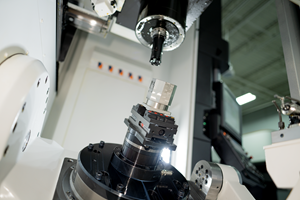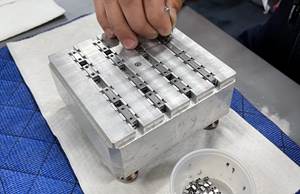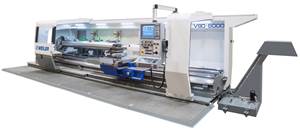System Takes Guesswork Out Of Diagnosing Problems
Rockwell Automation Power Systems (Greenville, South Carolina) specializes in technologies and services for optimizing power transmission performance and productivity.
Rockwell Automation Power Systems (Greenville, South Carolina) specializes in technologies and services for optimizing power transmission performance and productivity.
In 2000, the company developed an integrated process that targets improving plant-wide manufacturing processes. Aptly named Power Lean, the program integrates the tools and methodologies of lean enterprise, six sigma and total productive maintenance. The program has been implemented across multiple Power Systems plants and is focused on attaining bottom-line results. One facility reported the following results: a more than 20 percent reduction of total inventory; a more than 25 percent reduction in costs related to quality; and an 80 percent reduction in cycle times. The instance of on-time deliveries has increased by 99 percent, while productivity has increased by more than 35 percent.
A key component in this transformation has been the QC10 Ballbar system offered by Renishaw Inc. (Hoffman Estates, Illinois). "The ballbar is a powerful tool for us," says Larry Sykes, lean program manager. "Maintenance technicians now have an internationally recognized standard for assessing the dynamic motion and positioning precision of machine tools and production machinery."
"The system also provides us with a preventive and diagnostic tool to ensure that our machines are capable of producing the required part specifications," he explains.
Benefits to six sigma quality and lean efficiencies are also evident with this system. "Machine capability is critical when machining parts to tolerances in the tenths," says Bill Murphy of group maintenance. "At the same time, ballbar tests generate trend data. This assists technicians in instituting predictive and preventive maintenance, which, in turn, can keep machines functioning properly and part quality within the required specifications."
According to Mr. Sykes, the ability to perform proactive maintenance has reduced unexpected downtime, thus supporting the move to high-throughput, lean work scheduling. Under the predictive maintenance program, tests are conducted periodically to track performance. Additionally, tests are performed when a machining problem is suspected.
"Because the testing is relatively simple, the operator can minimize disruptions and downtime," explains Mr. Sykes. "About 15 minutes are required to inspect a machine."
The ballbar is a telescoping bar with machined balls at either end. It affixes magnetically to socket devices that are mounted to the machine’s spindle and bed. As the machine runs the ballbar through a sequence of programmed routines, a transducer tracks machine movements. The Ballbar 5HPS software converts the data into a polar plot of the machine’s true movement. It tracks machine movement to ±0.5 micron. Machine geometry, circularity and stick/slip error, servo gain mismatch, vibration, backlash, repeatability, and scale mismatch can then be assessed. In addition to diagnosing specific errors in accordance with ISO 230-4 and ASME B5.54 and B5.57 standards, the software ranks errors according to their overall effect on machining accuracy.
The 15-minute routine replaces the circle/diamond/square tests previously used to verify machining capability and accuracy. After these tests, the features could then be machined into a test piece that would proceed to the quality department. The system would then inspect the dimensions to make certain that the machine was able to properly produce the part. "If there happened to be a problem with feature geometry, however, the cause might not be obvious," notes Mr. Sykes.
The ballbar quick-check system, by comparison, enables users to evaluate a machine in 15 minutes and discern whether it can produce a good part. "If there is a problem, we can explore different possibilities," says Mr. Sykes. "The system determines which factor we need to address on the machine tool," he continues. "Adjustments can be made to parameters in the machine controller to offset ballscrew issues."
Also crucial to the company are the software’s trending abilities. A machine history function enables monitoring an individual machine through its life cycle to predict and schedule future maintenance.
With the Ballbar Plot Simulator, the user can explore "what if" scenarios. By simulating machine adjustments, this feature allows the maintenance technician to view the effects on ballbar data prior to making actual machine adjustments.
As a result of using the system, Rockwell Automation says it has been able to take corrective maintenance to a higher level, with lean time savings. Mr. Sykes recalls a CNC lathe with a damaged way that needed to be replaced. "Through working with the OEM and Renishaw, we captured sufficient accuracy information to replace and realign the way right here in the plant," he says.
"Previously, this would have necessitated sending the lathe back to the factory for the repair, which may have taken 2 months," Mr. Sykes continues. "Instead, our maintenance personnel completed the job on the shop floor in 3 weeks."
After plant and lean managers observed the ballbar demonstration at a Champions Forum instituted under the Power Lean program, other Power Systems plants adopted the system.
The emphasis on seeking and sharing innovative tools has been such a success internally for Power Systems that Rockwell Automation decided to expound upon the idea. After offering the program to customers and other industries, the company created a 4-week Power Lean Master Certificate Program with Clemson University.
"The Power Lean training program emphasizes hands-on training," says Mr. Sykes, who is now a program manager. "It consists of 2 days of classroom material, followed by 3 days of working on the shop floor and implementing the concepts just learned."
Related Content
Building a 5-Axis Cell
5-axis machining has taken over the metalworking industry, but what goes into a high-functioning 5-axis machining cell?
Read MoreBuilding an Automation Solution From the Ground Up
IMTS 2022 provides visitors the opportunity to meet with product experts to design automation solutions from scratch.
Read MoreNiche Work If You Can Get It: A CNC Machine Shop Crafts Its Own Destiny
The latest innovations in metalworking aren’t always related to CNC automation or robotics. For Rosenberger North America, a 2022 Top Shops Honoree, it is the company’s niche processes that create the biggest successes.
Read MoreWeiler to Debut New Automation Features For Its Lathes
Weiler’s V 110 four-way precision lathe introduces features new to the U.S.
Read MoreRead Next
3 Mistakes That Cause CNC Programs to Fail
Despite enhancements to manufacturing technology, there are still issues today that can cause programs to fail. These failures can cause lost time, scrapped parts, damaged machines and even injured operators.
Read MoreThe Cut Scene: The Finer Details of Large-Format Machining
Small details and features can have an outsized impact on large parts, such as Barbco’s collapsible utility drill head.
Read MoreObscure CNC Features That Can Help (or Hurt) You
You cannot begin to take advantage of an available feature if you do not know it exists. Conversely, you will not know how to avoid CNC features that may be detrimental to your process.
Read More



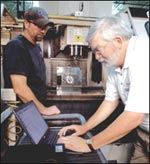
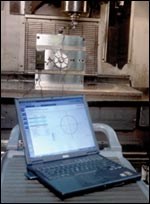









.png;maxWidth=300;quality=90)




